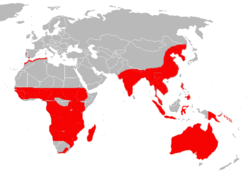Turnicidae
| Buttonquail | |
|---|---|
 |
|
| Black-breasted buttonquail (Turnix melanogaster) | |
| Scientific classification | |
| Kingdom: | Animalia |
| Phylum: | Chordata |
| Class: | Aves |
| Order: | Charadriiformes |
| Family: |
Turnicidae GR Gray, 1840 |
| Genera | |
 |
|
| Distribution of the buttonquails | |
Buttonquail or hemipodes are members of a small family of birds, Turnicidae, which resemble, but are unrelated to, the quails of Phasianidae. They inhabit warm grasslands in Asia, Africa, Europe, and Australia. There are 16 species in two genera, with most species being found in the genus Turnix and only one being found in the genus Ortyxelos.
Buttonquails are small, drab, running birds, which avoid flying. The female is the more richly-coloured of the sexes, and initiates courtship. While the quail-plover is thought to be monogamous, Turnix buttonquails are sequentially polyandrous; both sexes cooperate in building a nest in the earth, but normally only the male incubates the eggs and tends the young, while the female may go on to mate with other males. The eggs hatch after an incubation period of 12 or 13 days, and the young are able to fly within two weeks of hatching.
Buttonquail were traditionally placed in Gruiformes or Galliformes (the crane and pheasant orders). The Sibley-Ahlquist taxonomy elevated them to ordinal status as the Turniciformes and basal to other Neoaves either because their accelerated rate of molecular evolution exceeded the limits of sensitivity of DNA-DNA hybridization or because the authors did not perform the appropriate pairwise comparisons or both. Morphological, DNA-DNA hybridization and sequence data indicate that turnicids correctly belong to the shorebirds (Charadriiformes). They seem to be an ancient group among these, as indicated by the buttonquail-like Early Oligocene fossil Turnipax and the collected molecular data.
...
Wikipedia
